Back to the list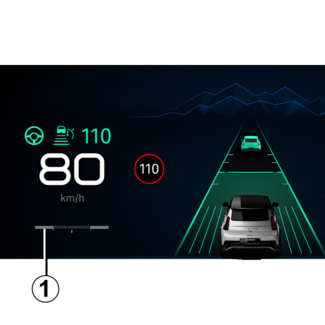
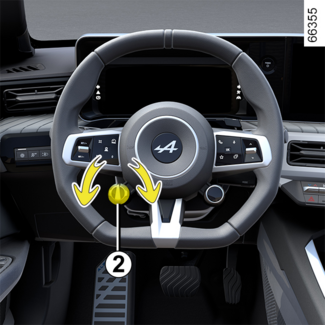
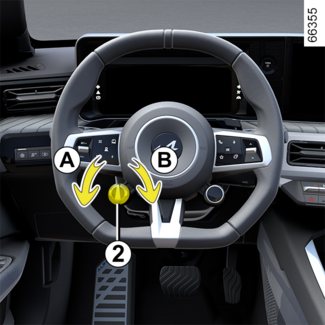

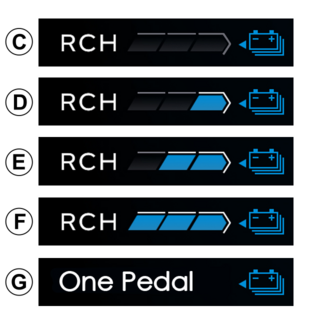

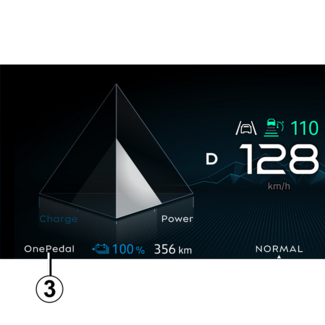
Regenerative braking system
Regenerative braking system
Introduction


By releasing the accelerator, the vehicle uses regenerative braking to slow down the
vehicle.
All of this energy is converted to electricity to recharge the traction battery.
The steering wheel control 2 can be used to increase or decrease regenerative braking.
WARNING
The regenerative braking should under no circumstances be used as a substitute for
the brake pedal.
Tip
Under certain conditions (fully charged battery too hot or too cold, engine hot, etc.),
the regenerative braking system performance will be limited, resulting in reduced
engine braking when releasing the accelerator pedal.
On the instrument panel, the power meter indicator 1 informs you of the available regenerative braking potential. Nevertheless, the braking
capacity when using the brake pedal will be preserved and will still enable the vehicle
speed to be limited.
Regenerative braking change control 2

The touch control 2 can be used to change the regenerative braking level:
- turn the control 2 towards A to increase the engine braking when you release the accelerator pedal;
- turn the control 2 towards B to reduce the engine braking when you release the accelerator pedal.
The level selected using control 2 does not act as long as the Adaptive Cruise Control function is activated STOP AND GO ADAPTIVE CRUISE CONTROL.
Driving with the regenerative braking control


Regenerative braking levels
Depending on the level selected using the control 2, the indicator 3 informs you of the regenerative braking level:
- C: "Free-wheel" level for a smooth and economical ride, associated to Save mode by default. Requires you to drive with greater anticipation;
- D: low engine braking when releasing the accelerator pedal, associated to Normal and Sport mode by default;
- E: medium engine braking when releasing the accelerator pedal;
- F: high engine braking when releasing the accelerator pedal;
- G: very high engine braking when the accelerator pedal is released and the One Pedal function is activated.
Note: when stopping the engine, the regenerative braking level is stored, with the exception
of the One Pedal function.
One Pedal function
On equipped vehicles, the One Pedal function facilitates driving in urban areas or heavy traffic, mainly by using the
accelerator pedal.
When you release the accelerator pedal sufficiently, the vehicle decelerates until
it comes to a complete stop.
When you release the accelerator pedal completely, the engine braking level is very
high.
Press the accelerator pedal sufficiently to regain speed.
Activation


With D position engaged, turn the control 2 in the direction of A as many times as necessary until the "One Pedal activated" message appears. The ONE PEDAL warning light 3 appears, accompanied by a beep, to confirm that it is activated.
Tip
The One Pedal function does not make an emergency stop and its braking performance is limited.
WARNING
This function is an additional driving aid. This function is not under any circumstances
intended to replace the due care and attention of the driver, who should at all times
be in control of the vehicle.
Note: with your vehicle stationary, the "One Pedal" function activated and D position engaged, the vehicle will not move when you release the brake pedal.
Put on standby
The One Pedal function goes on standby when R or N is engaged.
The ONE PEDAL warning light is displayed in grey on the instrument panel.
Note: with D, R position engaged, if the vehicle is stationary it will move forward as soon as you
release the brake pedal (without pressing on the accelerator pedal).
Shifting to D position reactivates the function when the vehicle speed is above approximately 6
mph (10 km/h). The ONE PEDAL warning light appears in white to confirm reactivation.
Note:
- the parking brake is applied automatically when the vehicle remains stationary for more than approximately three minutes.
Deactivation
To deactivate the function:
- while driving, turn the control 2 in the direction of B;
- when stationary, press the brake pedal and then turn the control 2 in the direction of B.
The "One Pedal deactivated" message is displayed on the instrument panel. The ONE PEDAL warning light 3 disappears, accompanied by a beep, to confirm deactivation.
The function is automatically deactivated if the engine is stopped by pressing the
engine start/stop button. You must reactivate the function as needed after restarting.
Limits of operation
- On low-grip surfaces (frost, snow, etc.), it is recommended to use the first levels C or D and to use the brake pedal to manage heavy deceleration and stopping phases DRIVING WITH THE REGENERATIVE BRAKING CONTROL.
- In the case of a steep slope, with the accelerator pedal released, the One Pedal function may not be sufficient to keep the vehicle stationary. Make sure the vehicle is stationary by pressing the brake pedal or activating the electronic parking brake.
Operating faults
When the system detects an operating fault the "One Pedal to check" message is displayed on the instrument panel. The function is no longer available.
Consult an approved dealer.